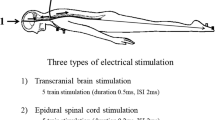Summary
Effects of stepwise distraction of the spinal cord on the spinal cord evoked potentials (SEP) were studied in cats. During the distraction between two adjacent cervical vertebrae, the SEP was examined upon single electric shocks to the lower spinal cord level (ascending SEP). The SEP was recorded from three points in the epidural space of the distracted spinal cord. Among the three sites the central site showed suppression of the ascending SEP earliest and most severely. The critical point for reversibility of spinal cord function should be set at a 30% amplitude decrease from the control SEP. Monitoring of the SEP at the central site of two cervical vertebrae seems to be best during corrective surgery to avoid possible damage to the spinal cord.
Access this chapter
Tax calculation will be finalised at checkout
Purchases are for personal use only
Preview
Unable to display preview. Download preview PDF.
Similar content being viewed by others
References
Baba H (1986) Experimental studies of the spinal cord evoked potentials in cats. (in Japanese) J Jpn Orthop Ass 60: 623–636
Dolan EJ, Transfeldt E, Tator CH, Simmons EH, Hughes KF (1980) The effect of spinal distractionon regional spinal cord blood flow. J Neurosurg 53: 756–764
Jones SJ, Edgar MA, Ransford AO (1984) Epidural recording of spinal SEPs following posterior tibial nerve stimulation in man. Conduction properties of normal human spinal cord and changes during scoliosis correction. In: Homma S, Tamaki T (eds) Fundamentals and clinical application of spinal cord monitoring. Saikon Publishing, Tokyo, pp 223–236
Kawahara K (1988) Experimental studies on the spinal cord evoked potentials in the cervical spine distraction injury. (in Japanese) J Juzen Med Soc 97: 672–687
Nagata S (1988) Experimental studies on the spinal cord evoked potentials in compression injury of the cervical spinal cord. J Juzen Med Soc 97: 688–703 (in Japanese)
Nordwall A, Axelgaard J, Harada Y, Valencia P, Mcneal DR, Brown JC (1979) Spinal cord monitoring using evoked potentials recorded from feline vertebral bone. Spine 4: 486–494
Author information
Authors and Affiliations
Editor information
Editors and Affiliations
Rights and permissions
Copyright information
© 1991 Springer-Verlag Berlin Heidelberg
About this paper
Cite this paper
Kawahara, N. et al. (1991). Experimental Studies on the Spinal Cord Evoked Potentials in Cervical Spine Distraction Injuries. In: Shimoji, K., Kurokawa, T., Tamaki, T., Willis, W.D. (eds) Spinal Cord Monitoring and Electrodiagnosis. Springer, Berlin, Heidelberg. https://doi.org/10.1007/978-3-642-75744-0_16
Download citation
DOI: https://doi.org/10.1007/978-3-642-75744-0_16
Publisher Name: Springer, Berlin, Heidelberg
Print ISBN: 978-3-642-75746-4
Online ISBN: 978-3-642-75744-0
eBook Packages: Springer Book Archive




